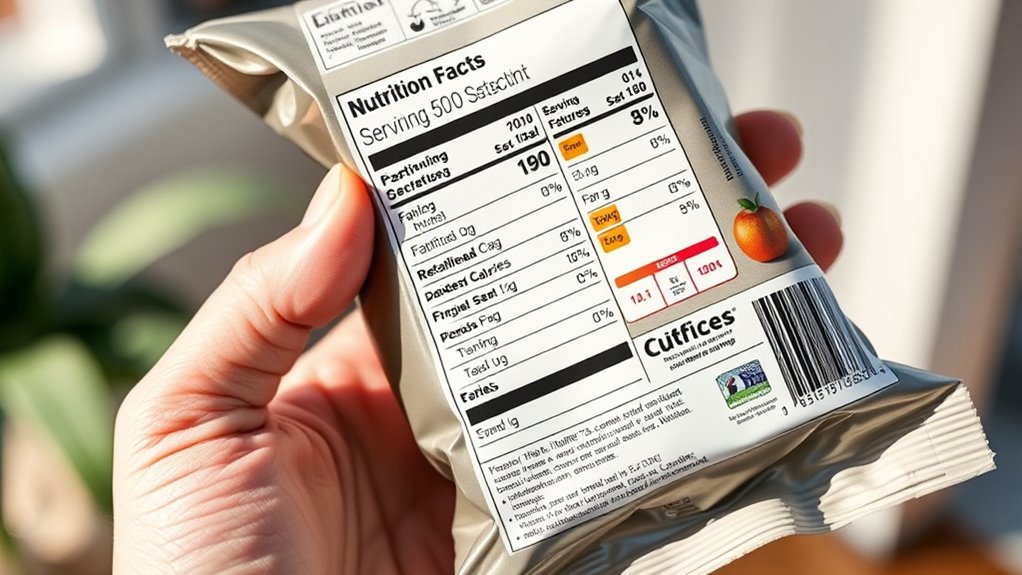To read nutrition labels like a dietitian, start by checking the ingredient list for natural foods and potential allergens, and look for added sugars, preservatives, and unhealthy fats. Pay close attention to portion sizes, ensuring you understand how many servings you’re consuming. Review the macronutrient and micronutrient information to meet your health goals, compare products for better options, and recognize important details on the nutrition panel. Keep these tips in mind as you continue exploring smarter shopping choices.
Key Takeaways
- Always start by reviewing the serving size to understand the nutrient amounts relative to portion.
- Examine the ingredients list for added sugars, artificial additives, and potential allergens.
- Check the calorie count and macronutrients (fat, protein, carbs) to align with your dietary goals.
- Compare micronutrient content and % Daily Values to assess nutrient density and health benefits.
- Look for products with cleaner ingredients and lower sodium, added sugars, and unhealthy fats for healthier choices.

Understanding how to read nutrition labels is essential for making healthier food choices. When you become familiar with the information presented, you gain better control over what you eat and how it impacts your health. One of the most important skills is developing ingredient awareness. By carefully examining the ingredient list, you can identify potential allergens, added sugars, preservatives, or artificial ingredients that might not align with your dietary goals. Recognizing these components helps you select products with cleaner, more natural ingredients, ensuring you’re fueling your body with wholesome foods. Additionally, ingredient awareness can alert you to hidden sources of unhealthy fats or excessive sodium, which are often concealed in processed foods.
A critical aspect of reading nutrition labels is understanding portion control. The serving size listed on the package might not match the amount you typically eat, so it’s important to pay close attention. If a label indicates that one serving contains 200 calories but the package contains multiple servings, you’re actually consuming a much higher calorie count than it appears at first glance. Learning to interpret these numbers helps you manage your intake more accurately, preventing accidental overeating. Measuring your portions or using the serving size as a guide can help you stay aligned with your dietary goals. Remember, even healthy foods can become problematic if you consume them in excessive amounts, so portion control is key.
As you read the label, focus on the macronutrients—fat, protein, and carbohydrates. Understanding how these nutrients contribute to your daily intake enables you to balance your meals effectively. For example, if you’re aiming to reduce saturated fat, look for items with lower amounts per serving. Similarly, if you’re monitoring carbohydrate intake for blood sugar management, check the total carbs and added sugars. The nutrition facts panel also provides information about micronutrients like vitamins and minerals, which can help you meet specific health needs. Knowing about acceptable daily intakes for certain nutrients can guide you in making balanced choices that support overall health.
Lastly, don’t forget to compare different products. Even within the same food category, labels can vary considerably. By comparing the nutrition facts and ingredients across brands, you can choose options that better fit your health goals. Being proactive and attentive while reading labels empowers you to make smarter decisions, ultimately supporting your overall well-being. Remember, the more you practice these habits, the more natural it becomes to select foods that nourish your body and avoid unnecessary additives or excess calories.
Frequently Asked Questions
How Often Should I Check Nutrition Labels When Shopping?
You should check nutrition labels every time you shop to make informed choices. Focus on reading portion sizes to understand how much you’re consuming and compare labels for label accuracy between products. This habit helps you stay aware of nutrient content and avoid surprises. Regularly reviewing labels ensures you’re mindful of ingredients, calories, and other essential info, empowering you to maintain a healthier diet and stick to your nutritional goals.
Are There Specific Ingredients to Avoid on Labels?
Think of labels as a secret code you’re deciphering. You should avoid products with artificial additives and preservative ingredients, as they can be unhealthy or cause allergies. Look out for unfamiliar chemical names or long ingredient lists. Instead, choose items with simple, natural ingredients. Your goal is to nourish your body, not just fill it with questionable substances hiding behind labels. Stay vigilant, and your health will thank you.
How Do Serving Sizes Affect Nutrient Calculations?
You need to understand that serving size accuracy directly impacts nutrient estimation techniques. When a label lists a specific serving size, all nutrient values are based on that amount. If you eat more or less, you must adjust the calculations accordingly. Always check the serving size first, then multiply or divide nutrient amounts to match your actual intake, ensuring accurate tracking of calories, fats, proteins, and other nutrients.
What Are Hidden Sugars Commonly Found on Labels?
Hidden sugars often sneak into food labels as ingredients like corn syrup, dextrose, or maltose, making it tricky to spot natural sugars versus artificial sweeteners. You might see added sugars listed under various names, hiding their true amount. Always check the ingredients and nutrition facts for these hidden sugars, as they can spike your calorie intake without you realizing, even if the product claims to be low in sugar or “sugar-free.”
Can Nutrition Labels Help Identify Allergies or Sensitivities?
Think of nutrition labels as your personal allergy detective. They can reveal hidden clues like gluten-free claims and organic labels, helping you spot potential triggers. By scrutinizing ingredients and allergy warnings, you can navigate the food jungle safely. Labels don’t just tell you what’s inside—they protect your health, guiding you toward choices that respect your sensitivities and keep you feeling your best.
Conclusion
Now that you know how to decode nutrition labels, you’re like a modern-day Sherlock, uncovering hidden clues about what truly fuels your body. Remember, every label tells a story—so read between the lines and make smarter choices. Just as detectives crack codes, you can master this skill to lead a healthier life. Keep this knowledge close, and soon, reading labels will become second nature—your secret weapon for better nutrition every day.









